Oman is officially known as the Sultanate of Oman and is a monarchy.
The current head of state is His Majesty Sultan Haitham bin Tarik.
It is the third largest country in the Arabian Peninsula.
Let us explore the population statistics of Oman in 2024 and gain a better understanding of the region.
Oman Population Statistics 2024 (Key Statistics)
In 2024, The total population of Oman is 4.71 million.
The population density is 15.1 per km2.
The median age is 29.2 years.
The total land area is 309,500 km2.
Muscat is the capital city of Oman.
The male population is 2.85 million while the female population is 1.86 million.
The population in urban areas is 4.17 million while the population in rural areas is 0.54 million people.
Oman is an Islamic nation, with 4.28 million Muslims residing there.
Among the Oman cities, Muscat has the highest population with 797,000 people.
Oman Population Statistics 2024 (Infographics)

Population According to Different Sources
worldometers.info | 4.69 Million |
worldpopulationreview.com | 4.69 Million |
Datareportal | 4.68 Million |
Statista | 5.26 Million |
populationpyramid.net | 4.71 Million |
Macrotrends | 4.71 Million |
When we search for Oman’s population in 2024, we get different statistics from different sources.
While worldometers.info and worldpopulationreview.com suggest a population of 4.69 million people, Datareportal records it as 4.68 million people.
Similarly, populationpyramid.net and Macrotrends record a population of 4.71 million.
The highest population is recorded by Statista which is 5.26 million.
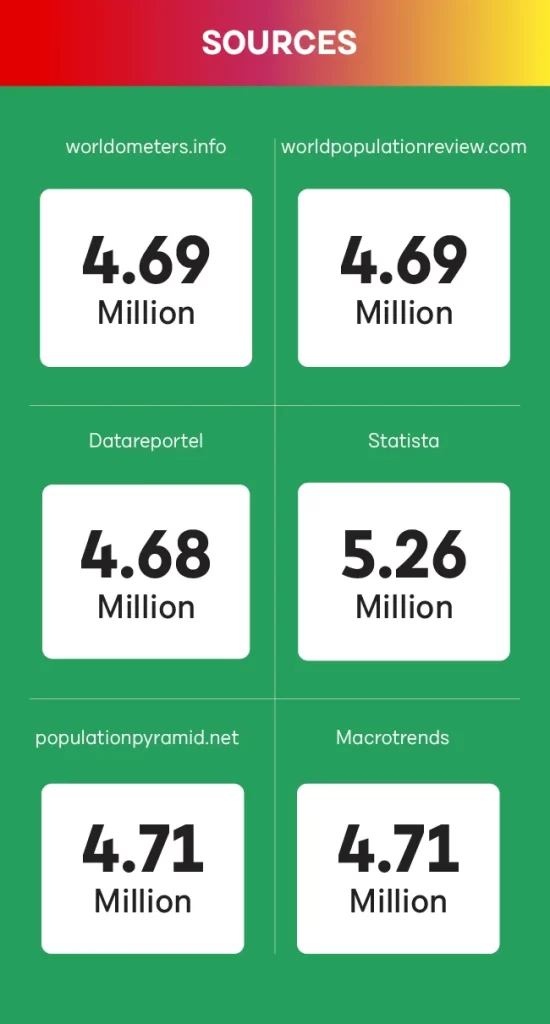
General Information
Population Density | 15.1 per Km2 |
Median Age | 29.2 Years |
Total Land Area | 309,500 Km2 |
Capital City | Muscat |
Oman, situated in the Arabian Peninsula, uses Arabic as its official language and conducts transactions using the Rial (OMR) as its official currency.
Governed by Sharia law, the country reveres the Sultan’s authority as absolute, shaping its legislative landscape.
Despite its vast land area of 309,500 square kilometers and a low population density of only 15.1 individuals per square kilometer, Oman’s median age is 29.2 years.
This indicates potential opportunities and challenges in its socio-economic development journey.
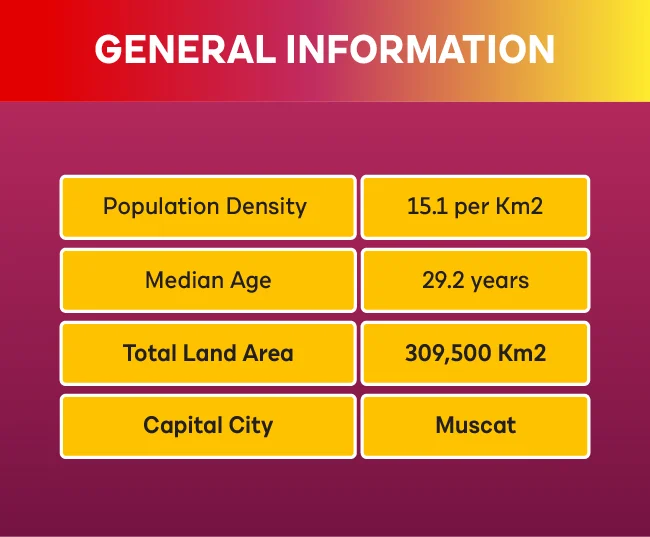
Demographics of Oman 2024
When we look at the demographics of Oman, we come across several interesting facts.
Let’s analyse a few:
Gender Split
Gender | Percentage | Population |
Male | 60.54% | 2.85 Million |
Female | 39.46% | 1.86 Million |
With males making up 60.54% (around 2.85 million) and females making up 39.46% (approximately 1.86 million) of the population, Oman’s demographic landscape shows a predominantly male society.
The higher percentage of men in Oman may stem from labor migration, especially in industries like construction and oil.
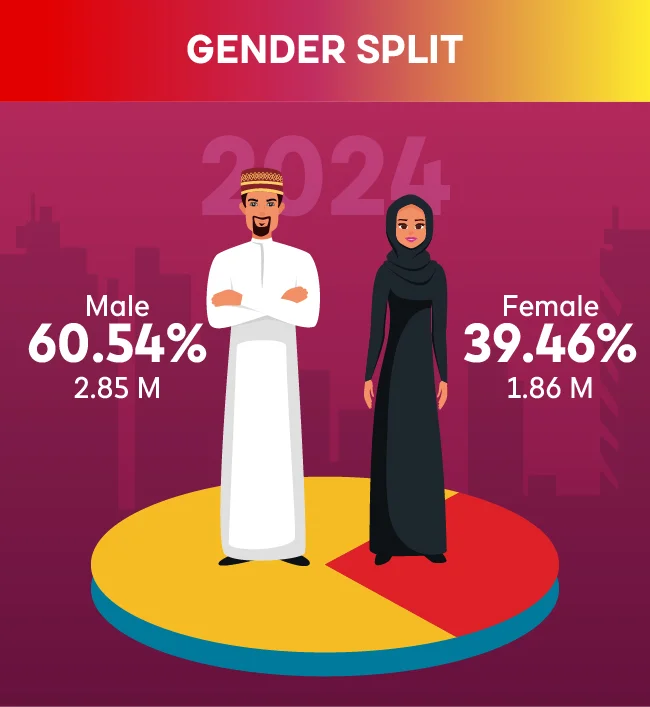
Oman Population By Age
Age Group | Percentage | Population |
0-14 Years | 26.82% | 1.26 Million |
15-24 Years | 12.27% | 0.58 Million |
25-54 Years | 53.64% | 2.53 Million |
55-64 Years | 4.38% | 0.21 Million |
65 Years and Over | 2.90% | 0.14 Million |
Oman’s population distribution reveals a significant proportion of its population in the working-age group, with 53.64% (around 2.53 million) aged between 25 and 54 years.
The younger age groups, 0-14 years and 15-24 years, collectively account for 39.09% (approximately 1.84 million) of the population, indicating a considerable youth demographic that will shape Oman’s future socio-economic landscape.
We can see that the older age group has a lower representation in the Oman population.
For example, the age group of 55-64 years occupies 4.38% of the population, which is 0.21 million.
65 years and older occupy only 2.90% of the population, which is 0.14 million.
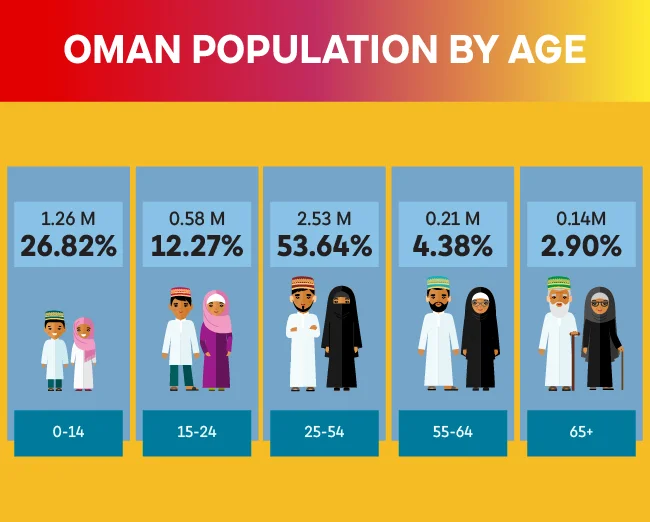
Oman Population By Gender
Age Group | Men Population | Women Population |
0-14 Years | 0.64 Million | 0.62 Million |
15-24 Years | 0.31 Million | 0.27 Million |
25-54 Years | 1.71 Million | 0.82 Million |
55-64 Years | 0.13 Million | 0.08 Million |
65 Years and Over | 0.07 Million | 0.07 Million |
In Oman, the population distribution by age and gender shows that men outnumber women in most age groups, particularly in the 25-54-year category, where the male population is 1.70 million and the female population is only 0.82 million.
As age increases, there is a more balanced distribution in men’s and women’s ratios.
For example, in the category of 55-64 years, men account for 0.13 million, and women account for 0.08 million.
Surprisingly, we see that in the 65-year-above age group, both men and women have the same number, 0.07 million each.
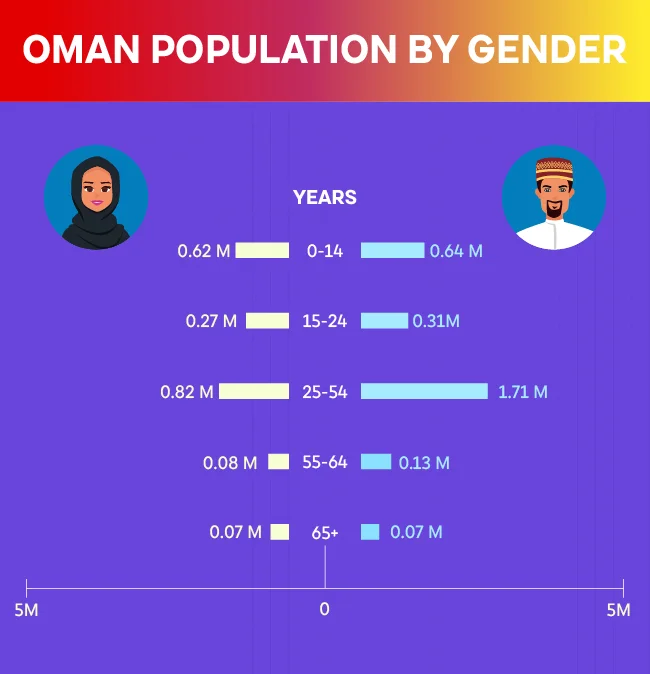
Oman Population 2024 (Urban V/s Rural)
Urban | 88.60% | 4.17 Million |
Rural | 11.40% | 0.54 Million |
The majority of Oman’s population resides in urban areas, accounting for 88.60% (approximately 4.17 million).
While the rural population comprises 11.40% (around 0.54 million), reflecting a significant urbanization trend in the country.
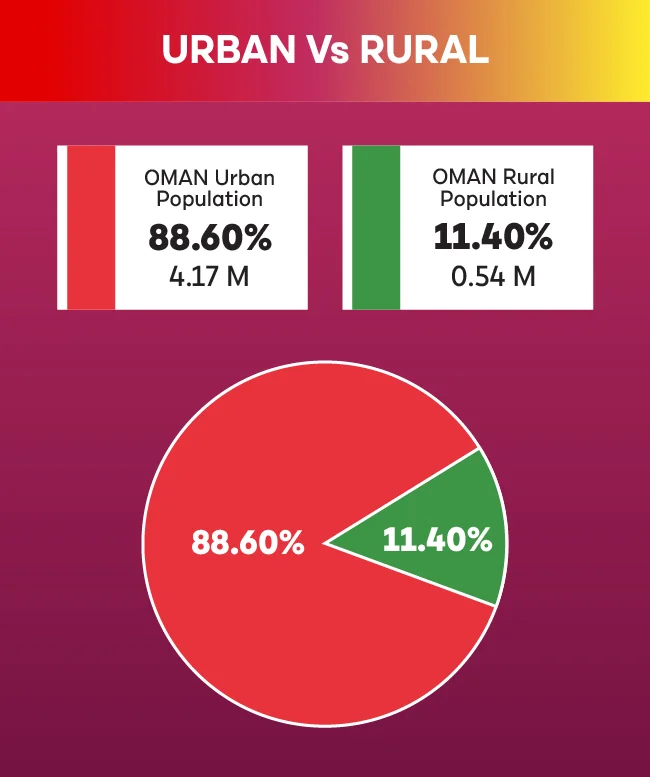
Oman Population By Year
Year | Population |
2024 | 4.71 Million |
2023 | 4.64 Million |
2020 | 4.54 Million |
2019 | 4.60 Million |
2018 | 4.60 Million |
2017 | 4.54 Million |
2015 | 4.19 Million |
2010 | 2.88 Million |
2005 | 2.52 Million |
2000 | 2.34 Million |
Oman’s population has undergone significant growth over the past two decades, reflecting both natural increase and migration trends.
In 2000, the population stood at 2.34 million, experiencing a steady rise to 2.52 million by 2005.
Subsequent years saw continued expansion, with the population reaching 4.19 million in 2015 and 4.54 million in 2017.
Despite slight fluctuations, the overall trend remained upward, with the population reaching 4.60 million in both 2018 and 2019.
By 2020, it had decreased to 4.54 million, followed by a slight increase to 4.64 million in 2023 and further growth to 4.71 million in 2024.
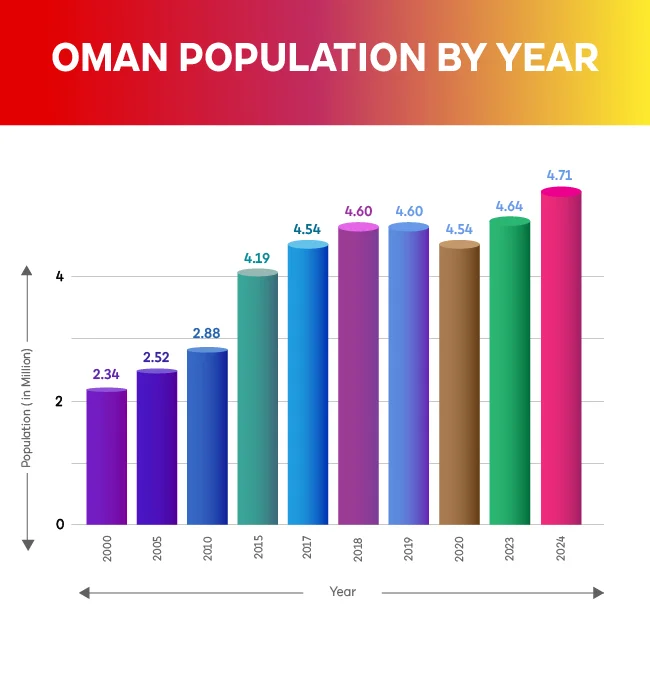
Oman Population By Religion
Religion | Percentage | Population |
Islam | 90.90% | 4.28 Million |
Hinduism | 4.70% | 0.22 Million |
Christianity | 2.90% | 0.14 Million |
Other/Small | 0.80% | 0.04 Million |
Buddhism | 0.50% | 0.02 Million |
Non Religious | 0.20% | 0.01 Million |
Oman’s religious landscape is predominantly Islamic, with 90.90% of the population adhering to Islam, accounting for approximately 4.28 million individuals.
Hinduism, Christianity, and Buddhism represent smaller religious communities, comprising 4.70% (0.22 million), 2.90% (0.14 million), and 0.50% (0.02 million) of the population, respectively.
Additionally, there are smaller groups of individuals categorized as “Other/Small” religions, constituting 0.80% (0.04 million) of the population, while those identifying as non-religious make up 0.20% (0.01 million).
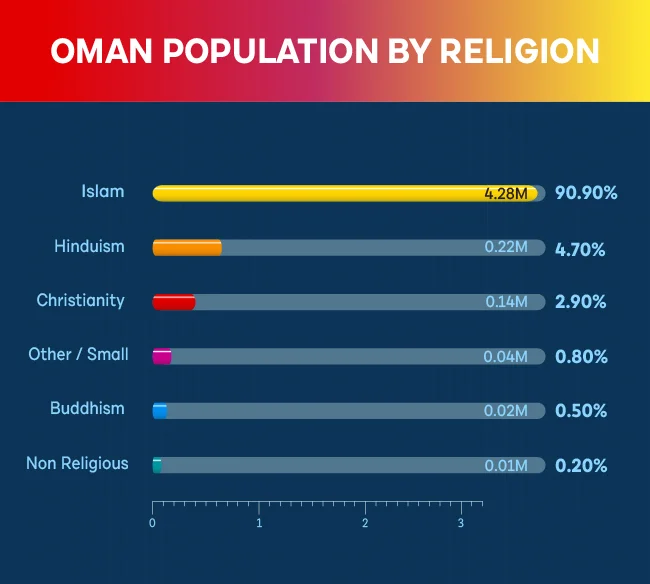
Oman Population by City
City | Population |
Muscat | 797,000 |
Seeb | 237,816 |
Salalah | 163,140 |
Bawshar | 159,487 |
Sohar | 108,274 |
As Suwayq | 107,143 |
`Ibri | 101,640 |
Saham | 89,327 |
Barka’ | 81,647 |
Rustaq | 79,383 |
Muscat stands as the most populous city, with approximately 797,000 residents.
Muscat’s status as the capital and economic hub attracts a significant portion of the population.
The second and third positions are occupied by Seeb, with 237,816 residents, and Salalah, with 163,140 residents.
Other significant urban centers include Bawshar (159,487), Sohar (108,274), As Suwayq (107,143), `Ibri (101,640), Saham (89,327), Barka’ (81,647), and Rustaq (79,383), each contributing to the country’s urban fabric and socio-economic dynamics.
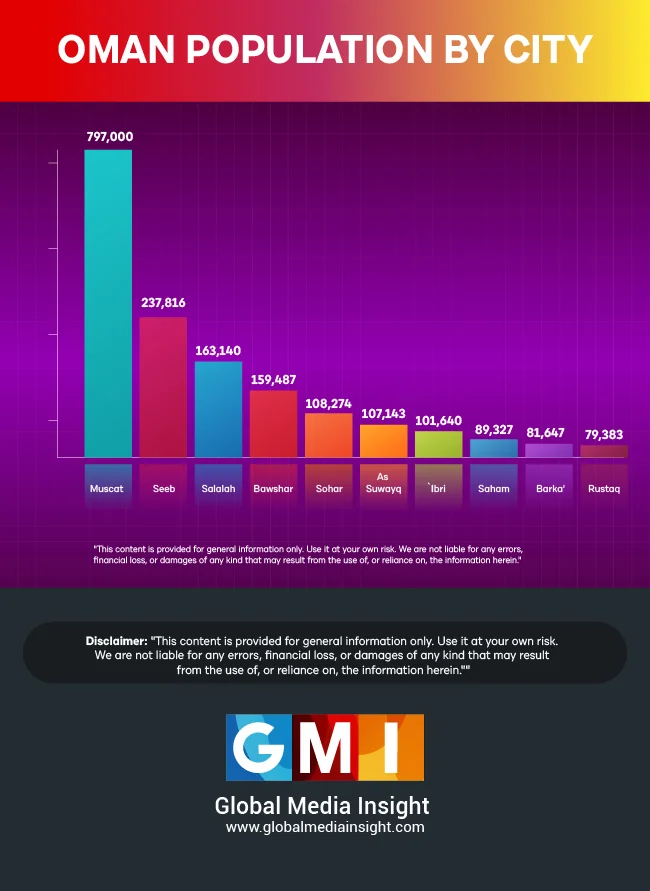
Oman Population by Nationality 2024
Nationality | Population |
India | 766,735 |
Bangladesh | 718,856 |
Pakistan | 268,868 |
Egypt | 46,970 |
Philippines | 45,213 |
Uganda | 20,886 |
`Sri Lanka | 20,003 |
Tanzania | 17,077 |
Nepal | 16,580 |
Indonesia | 14,155 |
Ethiopia | 13,572 |
Other Countries | 259,258 |
Currently, Oman is home to a multicultural expatriate population making a substantial impact on the nation’s demography.
The largest is the Indian community, which consists of 766,735 people, attributed to the country’s economic and cultural relations with Oman.
Bangladeshis come second with 718, 856 followed by Pakistanis with 268, 868.
Another major group of the expatriate population includes Egyptians, 46,970 and Filipinos, 45,213.
Other minorities include Ugandans and Sri Lankans who are 20,886 and 20,003 in number respectively.
The Tanzanian community is comprised of 17,077 people, and Nepalis contribute 16,580 people to the mix.
The Indonesians and Ethiopians are among the diverse workers present with numbers of 14,155 and 13,572 respectively.
Besides, 259,258 people from other countries contribute to the multicultural diversity of the Omani population.
These expat communities are thus beneficial to the development of Oman’s society and provide evidence to support Oman’s status as a country that attracts talent and human capital from across the globe.
Disclaimer: This content is provided for general information only. Use it at your own risk. We are not liable for any errors, financial loss, or damages of any kind that may result from the use of, or reliance on, the information herein.

GMI’s Research Team is a panel of knowledgeable experts from various fields such as digital marketing, social media, and web development, all united by a common goal—to educate. We enjoy exploring everything from the latest industry trends and emerging technologies to people and demographics, both in the UAE and beyond. Through our blog posts, we share valuable insights that help businesses and marketers stay informed and prepared for the challenges and opportunities that lie ahead.









